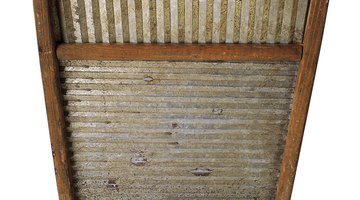How to Make an Old-Fashioned Washing Board
Create your own washboard for off-the-grid living and add to your percussion section at the same time. Doing laundry by hand saves your delicate washables, reduces electricity consumption and stems water usage. You can make your own washboard with supplies from your local hardware store.

The homemade washboard is perfect for camping trips or cottage living where electricity or water needs to be conserved. Your washboard can double as a musical instrument -- take a leftover wooden dowel and run it over your washboard to add a funky riff to jam sessions.
Things You Will Need
- Sandpaper
- Measuring tape
- Block of wood 2 feet wide and 4 feet long
- Staple gun and staples or small nails and a hammer
- 18, 1 inch by 4 foot dowels
- Hacksaw
- Lacquer
- Paint brush
Warning
Check the staples (or nails) regularly. If they begin to work their way loose, bang them back in with a hammer. Protruding nails or staples can cause injury and snag your clothing.
-
Cut the dowels in half using the hacksaw so you have two dowels which measure 2 foot each. Smooth the ends of the dowels with the sandpaper. Splinters may cause injury or snag clothing.
-
Sand the wooden block. Measure 1 foot from the top and mark it with a pencil. Lay the wooden dowels horizontally on the board. There should be 36 dowels. This should leave 1 foot of board at the top of the washboard and dowels all the way to the bottom of the board.
-
Staple each dowel to the board at both ends. Ensure that the staples are properly embedded into the dowel to prevent snagging. If you don't have a staple gun, use small nails to secure the dowels to the board.
-
Coat the entire washboard with lacquer to preserve the wood. Allow the lacquer to dry before using the washboard.
The Drip Cap
- Create your own washboard for off-the-grid living and add to your percussion section at the same time.
- Your washboard can double as a musical instrument -- take a leftover wooden dowel and run it over your washboard to add a funky riff to jam sessions.
- Splinters may cause injury or snag clothing.
- Lay the wooden dowels horizontally on the board.
References
Resources
Writer Bio
Nicole Fotheringham has been a writer since 1997. She was born in South Africa and began as a reporter for the "Natal Mercury" and "Cape Argus" newspapers. Fotheringham has a master's degree in English literature from the University of KwaZulu-Natal.
Photo Credits
- Comstock/Comstock/Getty Images
- Comstock/Comstock/Getty Images
More Articles



